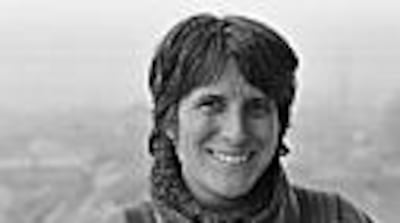Elizabeth Gowing has been living in Tirana for more than five years. She moved there because of her partner's job and now runs a monthly environmental networking group, and supports volunteers in reading programmes with the Roma community. Having learned the language, she also works as a translator.
Where is the first place you always bring people to when they visit?
One of the abiding images of Albania is of the over 70,000 pillbox “bunkers” built during the communist regime as part of the paranoid dictatorship’s defences against foreign invasion. Since the bunkers were designed to survive a direct grenade, they are very hard to destroy and remain studded over the landscape. The psychological and political legacy of that communist regime is still evident in Albania so when people come to visit, if they haven’t already noticed bunkers in the surrounding hills on their journey into town, we go to the “Corner of the Dictatorships” on the main boulevard, where a bunker is preserved so you can go inside. Not an upbeat start to an itinerary, perhaps, but it’s good to appreciate how far Albania has come since the dictatorship ended in 1991.
Where do you recommend for a great meal that gives a flavour of Tirana?
Located in Tirana’s photogenic Lake Park, Mullixhiu is a creative, delicious, stylish restaurant offering reworkings of traditional dishes. Savouring their pumpkin, persimmon and sundried tomato salad, for example, helps you rethink the preconceptions of Albania; this is a country whose identity and cuisine lies somewhere between the Mediterranean and the former Ottoman Empire.

Where is the best place to get a sense of Tirana’s place in history?
The self-styled “cafe museum” Komiteti is hung with artefacts which the knowledgeable serving staff will tell you about as you sip at something from their extensive list of traditional and herbal-flavoured raki brandies. Whether it’s looking at beautiful textiles, traditional carved furniture or the collection of every model of television and radio manufactured during the communist regime when Albania had to be self-sufficient, it’s a great place to learn as well as to drink.
The top three things to do there, that don’t cost money, are . . .
Tirana’s former mayor, now prime minister, famously brought his skills as an artist to painting Tirana’s buildings in harlequin colours and patterns, and the same approach has been adopted by his protegé, the new mayor, who has created a citywide game of I-Spy on the junction boxes.
Communism's art was for the people and socialist realist art is everywhere. See the vast mosaic in Tirana's central square, the bas reliefs on the government buildings and the massive Mother Albania statue with sheer cheekbones and biceps that could kill a bear.
Visit the exquisite paintings of the Et'hem Bey Mosque in Tirana's central square. Albania was pronounced the world's first atheist state in 1967, but since the fall of the regime there is easy coexistence between the country's majority Muslims, the Bektashi Muslims (whose world headquarters is in Tirana) and Orthodox and Catholic Christians (the world's most famous Albanian, Mother Teresa, is commemorated in a large Tirana square and statue).
What should visitors save room in their suitcase for after a visit to Tirana?
Some 40 minutes’ drive from Tirana is the town of Kruja, set on a dramatic escarpment and home to the country’s largest antiques and handcrafts market. Handwoven kilims, bold and sometimes gaudy traditional costumes and carved wood utensils can all be bought very affordably, and there is plenty of communist-era memorabilia on sale too. If you can’t get to Kruja check out the newly refurbished covered market in Tirana for the excellent “mountain tea”.
If you’d like to share your little black book of places to visit where you live overseas, please email your answers to the five questions above to abroad@irishtimes.com, including a brief description of what you do there and a photograph of yourself. We would love to hear from you.







